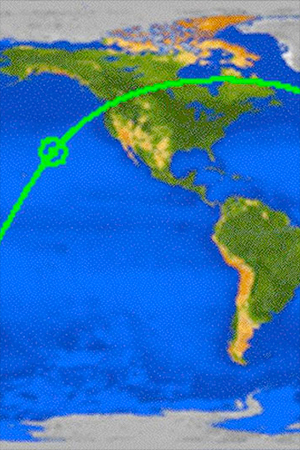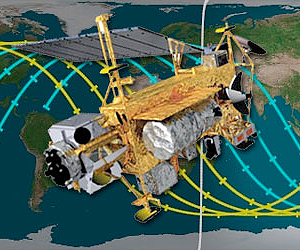 advertisements advertisements
|

|
NASA UARS likely hit ocean, but location of debris still unknown
September 24, 2011 — NASA's largest satellite to fall to Earth uncontrolled in more than 30 years is believed to have splashed down in the Pacific Ocean. But lacking any credible eyewitness reports, the space agency is not sure where exactly its 6-ton satellite re-entered, let alone where it dropped its debris, and may in fact, never know.
NASA's Upper Atmosphere Research Satellite, or UARS, began its fiery plunge sometime between 10:23 p.m. CDT Friday, Sept. 23 and 12:09 a.m. Sept. 24 (0323 to 0509 GMT Sept. 24) after orbiting the planet for more than 20 years. The Joint Space Operations Center at Vandenberg Air Force Base, in Calif., estimated two hours before the predicted re-entry time that the satellite would reach 50 miles (80 km) altitude at 11:16 p.m. on Friday (0416 GMT Saturday) and begin to break apart.
"The nominal location is 31 North and 219 degrees East, which is well in the Pacific, a good deal away from the western coast of the United States," Nick Johnson, chief scientist of NASA's orbital debris program at the Johnson Space Center in Houston, told reporters on Saturday. "We believe that UARS did come down during this period and I think that we have quite a bit of analytical data to support that."
"We're now waiting to see if we can verify that, particularly with perhaps some visual observation," Johnson said. "If it came down over one of the oceans, of course that is going to be problematic."
No credible satellite sightings
During the projected re-entry period, UARS was predicted to pass over Canada and Africa, as well as vast areas of the Pacific, Atlantic and Indian oceans. A lack of verified satellite sightings is leading NASA to believe that UARS dropped where their predictions had pointed, raining more than two dozen pieces of debris over the Pacific Ocean.
"There were several folks along the western coast of North America — the U.S. northwest and Canadian southwest — who were actually looking to observe UARS as it came over," Johnson said. "Every one of those attempts came up negative. So that would suggest that the re-entry did in fact occur before it reached the North American coast, which again would lead that most of this debris fell into the Pacific."
Reports circulating online that UARS was spotted falling over western Canada and even videos purporting to show the same turned out to be unreliable.
"We've got no reports of anyone seeing anything that we believe are credible," Johnson said. "We've got reports of people seeing things that were no where near the ground track and so you do have to filter that. But we are looking at every report that we receive, whether it is from an airliner, from someone on the ground and we will track those down. So far, we have found none that appear to be credible."
Debris dropped in the drink
Nor has Johnson heard of UARS's debris being recovered.
"I've got no reports that I've seen that talk about people that think they might have recovered debris," he said. Obviously, we're going to continue to keep our eyes and ears open and if we receive any reports like that, we'll try to go verify."
NASA said earlier that it expected up to 26 parts of the satellite to survive the fiery re-entry and reach the ground over a 500 mile (800 km) wide swath of Earth. A high-gain antenna gimbal, fuel tanks, batteries, and reaction wheel rims were among UARS's components large enough to make it to the surface. In total, the debris was judged prior to the fall to account for 1,100 pounds (500 kg) of the six ton UARS.
If UARS fell at or before the projected time and location, then its 500-mile-wide debris field would still be over the Pacific Ocean. Depending on their individual masses, the debris pieces would have taken between 5 and 10 minutes to splashdown from 50 miles high.
According to Johnson, UARS would have needed to have remained in orbit another 5 to 10 minutes before some of its debris may have reached land.
Wait and see
NASA hasn't given up on pinpointing where UARS fell.
"Clearly there are naval vessels and airlines over the oceans and sometimes it takes longer for those reports to make their way back to us," Johnson said. "So we're going to patient over the next several days. If we have sufficient evidence to better clarify when and where, we will certainly make that available."
"If we continue to have a lack of reports, particularly in Canada and Africa, of seeing something that looks like a re-entering UARS, then that would simply give further credence to the fact that it [dropped] over the water."
Even if UARS final resting place can never be verified, it won't be that unusual, Johnson said.
"This is not an unusual event. We do not always know precisely where these re-entries occur. This isn't a unique situation to UARS," he said. |
|

A green circle marks where over the Pacific Ocean NASA thinks its Upper Atmosphere Research Satellite re-entered. (NASA)

NASA's six-ton Upper Atmosphere Research Satellite (UARS) fell back to Earth after two decades in orbit. (NASA/Aerospace Corp.) |
|

© 1999-2025 collectSPACE. All rights reserved.
|
|

|

|
